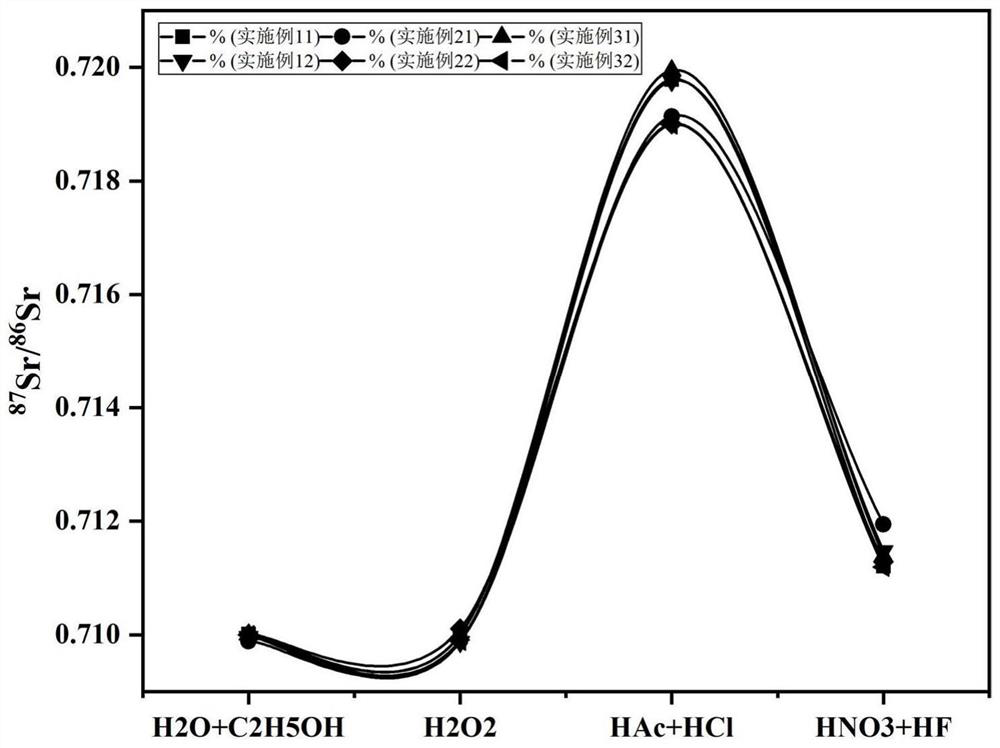Method for sequentially extracting strontium isotopes for silk cultural relics
A technology of silk fabrics and isotopes, applied in the field of cultural relics detection, can solve problems such as difficult detection of values, achieve the effects of eliminating interference, accurate results, and rich information
- Summary
- Abstract
- Description
- Claims
- Application Information
AI Technical Summary
Problems solved by technology
Method used
Image
Examples
Embodiment 1
[0024] 1) Cut 2g of the silk sample into pieces with scissors, put it into a centrifuge tube, add 10.00mL of a mixed solution of deionized water and ethanol (volume ratio: 1:1), and oscillate ultrasonically for 1 hour to dissolve the dust on the surface of the silk sample The particles and adsorbed soluble sodium salts were centrifuged at 4000r / min for 20min, the supernatant A1 was extracted and the residue B1 was kept for use.
[0025] 2) Slowly add 5.00mL of 15wt% hydrogen peroxide solution to the residue B1 while stirring, rely on the strong oxidation of hydrogen peroxide to oxidize and dissolve the insoluble substances in the sample, and centrifuge at 4000r / min for 20min, Extract the supernatant A2 for later use, and keep the residue B2 for later use.
[0026] 3) Add 10.00 mL of a mixed solution of 0.5 mol / L acetic acid and hydrochloric acid (volume ratio 1:1) to the residue B2, and ultrasonically oscillate for 1 hour, mainly used to dissolve carbonates in silk samples, C...
Embodiment 2
[0030] 1) Cut 2g of the silk sample with scissors, put it into a centrifuge tube, add 15.00mL of a mixed solution of deionized water and ethanol (volume ratio: 1:1), and oscillate ultrasonically for 1 hour to dissolve the dust on the surface of the silk sample The particles and adsorbed soluble sodium salts were centrifuged at 4000r / min for 20min, the supernatant A1 was extracted and the residue B1 was kept for use.
[0031] 2) Slowly add 7.50mL of 15wt% hydrogen peroxide solution to the residue B1 while stirring, rely on the strong oxidizing property of hydrogen peroxide to oxidize and dissolve the insoluble substances in the sample, and centrifuge at 4000r / min for 20min, Extract the supernatant A2 for later use, and keep the residue B2 for later use.
[0032] 3) Add 15.00 mL of a mixed solution of 0.5 mol / L acetic acid and hydrochloric acid (volume ratio 1:1) to the residue B2, and ultrasonically oscillate for 1 hour, which is mainly used to dissolve carbonates in silk sampl...
Embodiment 3
[0036] 1) Cut 2g of the silk sample into pieces with scissors, put it into a centrifuge tube, add 20.00mL of a mixed solution of deionized water and ethanol (volume ratio: 1:1), and oscillate ultrasonically for 1 hour to dissolve the dust on the surface of the silk sample The particles and adsorbed soluble sodium salts were centrifuged at 4000r / min for 20min, the supernatant A1 was extracted and the residue B1 was kept for use.
[0037] 2) Slowly add 10.00mL of hydrogen peroxide solution with a concentration of 15wt% to the residue B1 while stirring, rely on the strong oxidation of hydrogen peroxide to oxidize and dissolve the insoluble substances in the sample, and centrifuge at 4000r / min for 20min, Extract the supernatant A2 for later use, and keep the residue B2 for later use.
[0038] 3) Add 20.00mL of a mixed solution of 0.5mol / L acetic acid and hydrochloric acid (volume ratio: 1:1) to the residue B2, and ultrasonically oscillate for 1 hour. It is mainly used to dissolve ...
PUM
 Login to view more
Login to view more Abstract
Description
Claims
Application Information
 Login to view more
Login to view more - R&D Engineer
- R&D Manager
- IP Professional
- Industry Leading Data Capabilities
- Powerful AI technology
- Patent DNA Extraction
Browse by: Latest US Patents, China's latest patents, Technical Efficacy Thesaurus, Application Domain, Technology Topic.
© 2024 PatSnap. All rights reserved.Legal|Privacy policy|Modern Slavery Act Transparency Statement|Sitemap

